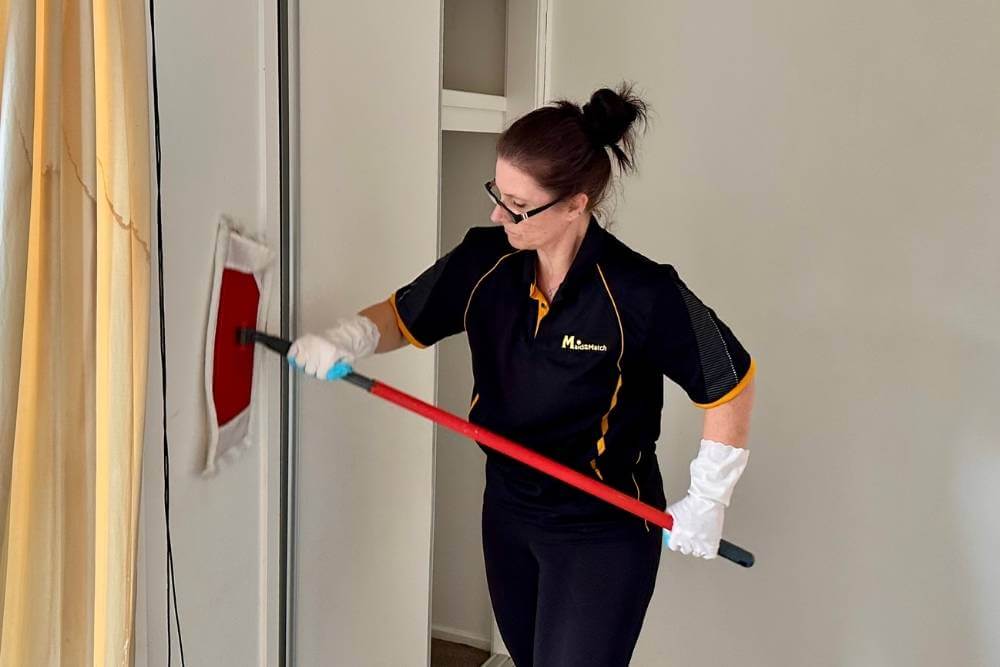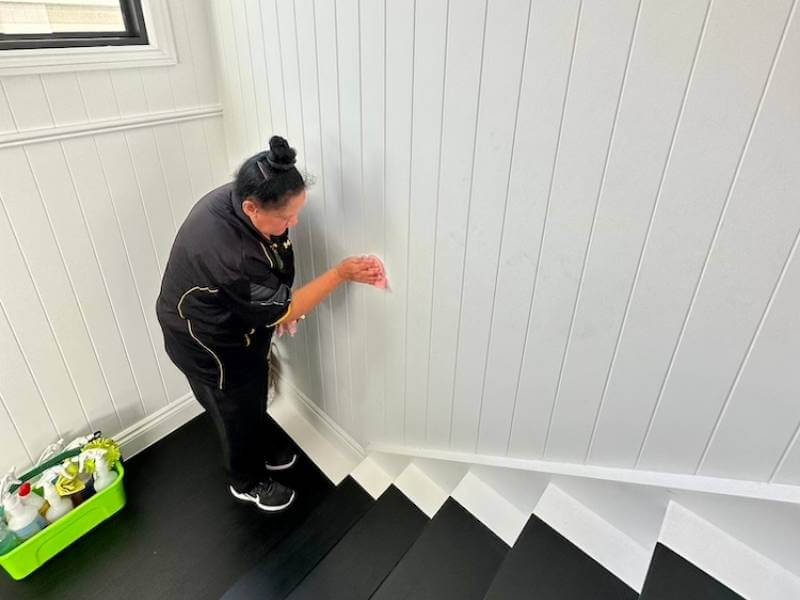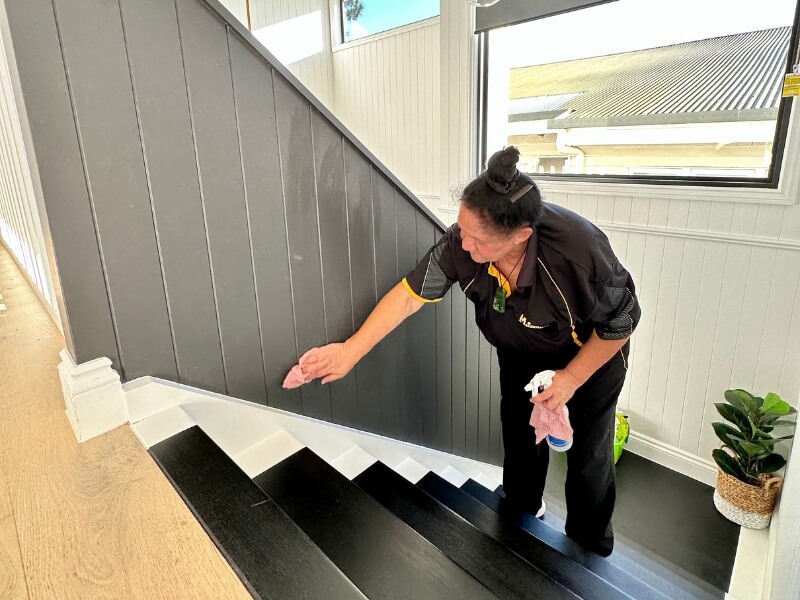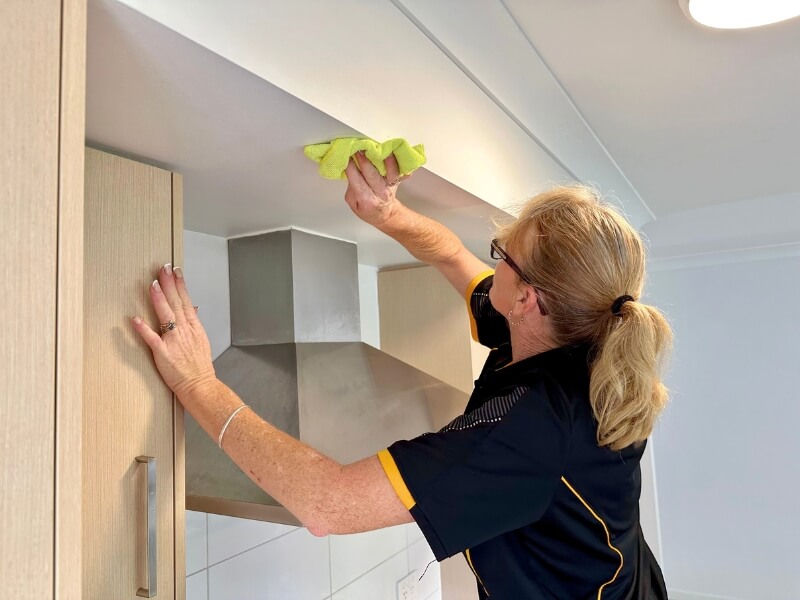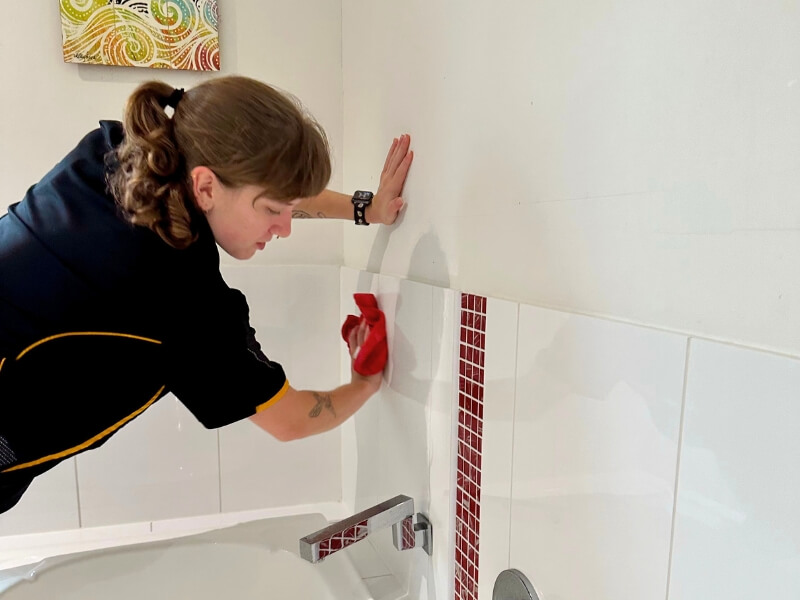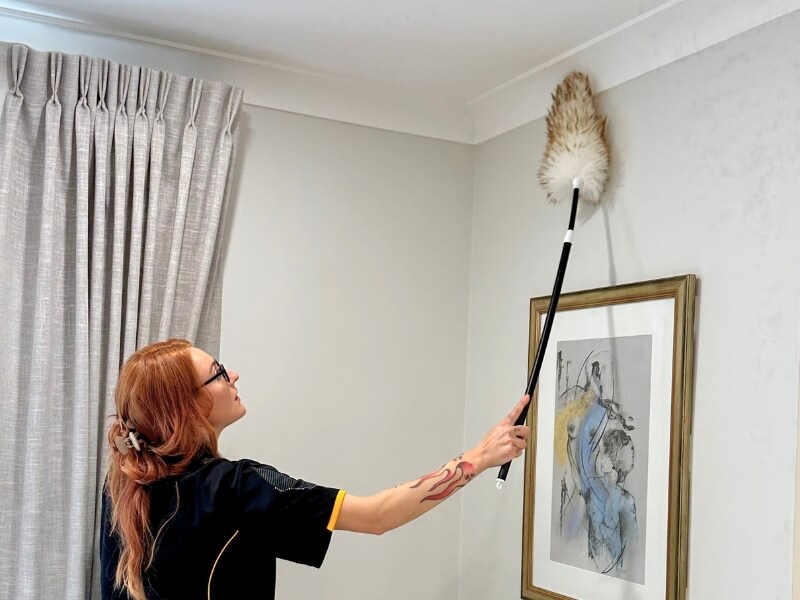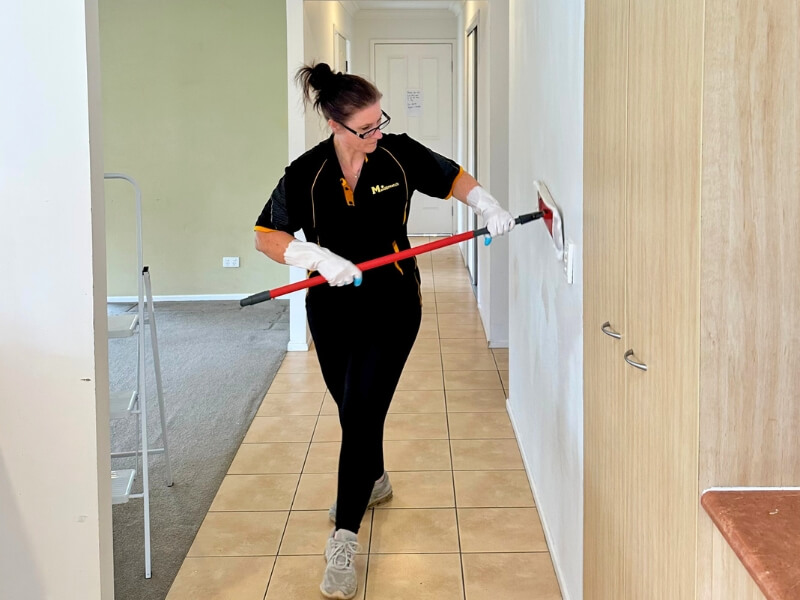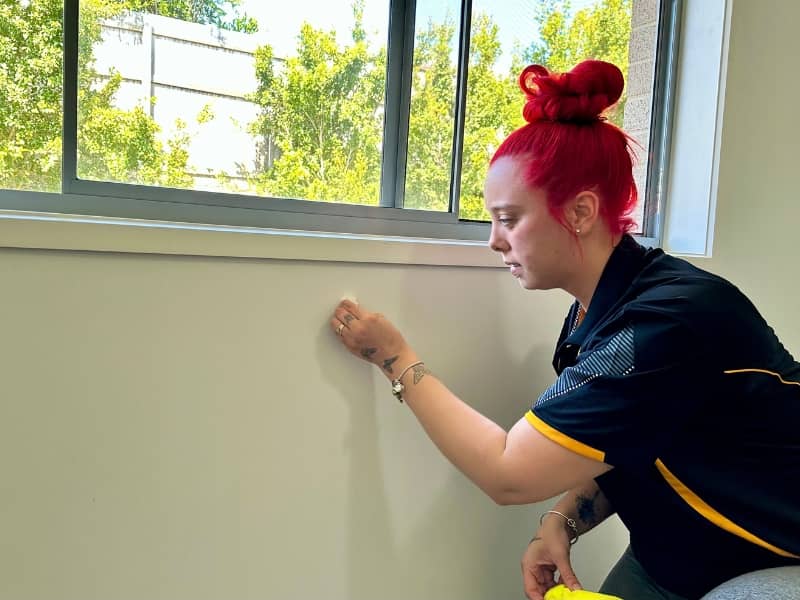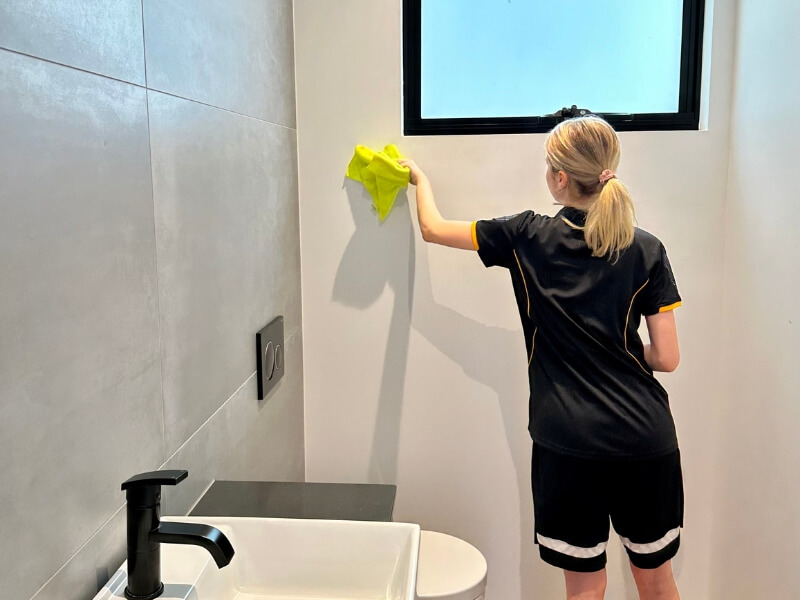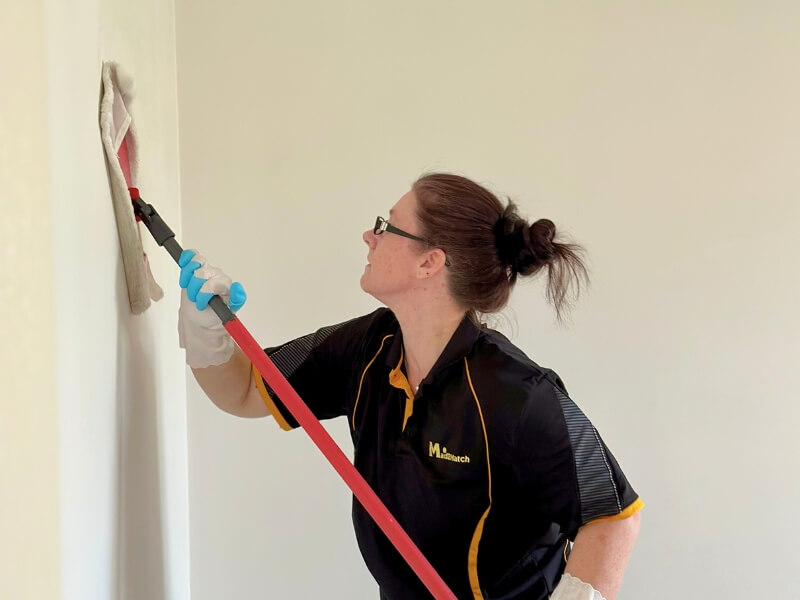Walls don’t get as much attention as other parts of the house, like floors or benchtops.
After all, it’s easy to assume that vertical surfaces stay clean — but that’s not true!
Over time, walls can collect dust, fingerprints, grease stains, scuffs, and even the occasional artwork (if you have kids).
Cobwebs and insect droppings can also gather in corners.
Fortunately, it’s easy to clean walls without damaging the paint and the surface underneath.
Spot cleaning and regular dusting can help keep your walls looking fresh. If a deep clean is needed, you can use a flat mop and warm, soapy water.
Keep reading to learn how to clean walls like a Maid2Match pro!
Before Cleaning | Cleaning Different Wall Types | Routine Cleaning | Deep Cleaning | Using Sugar Soap | Removing Stains | Bathroom Walls | Kitchen Walls
How Often Should You Clean Walls?
There’s no hard rule for how often to clean walls. It really depends on how much use the area gets.
Here, we put together a wall cleaning routine to guide you:
- Immediately: Spot clean stains as soon as you see them
- Weekly: Clean around high-touch spots like light switches
- Monthly: Dust walls to clear away cobwebs and loose dirt
- Yearly: Wash your walls thoroughly for a deep clean
Keep in mind that walls in high-traffic (hallways and living rooms) and humid spaces (bathrooms and kitchens) can get dirty faster.
Aim to clean these at least once a week.
Before Cleaning Your Walls
Cleaning your walls helps keep them looking great — as long as you don’t ruin them in the process!
Before getting started, always test your cleaning method to make sure it won’t cause any damage.
Dip a cotton swab into the cleaner, and dab it on an inconspicuous area. Wait a few minutes — if there’s no discolouration or damage, it’s safe to use.
Avoid harsh chemicals like ammonia and bleach. They can react with paint and leave permanent marks.
Also, skip abrasive tools like steel wool and stiff-bristle brushes.
Instead, use a microfibre cloth or a soft sponge. These clean effectively without scratching the surface.
When tackling a large area, prepare the space first.
Take down wall hangings like clocks and photos, and move furniture away so you have room to work.
It’s also best to clean walls before floors and skirting boards, since dust and dirt can fall as you go.
Lastly, try to identify what kind of surface you’re working with so you can use the right cleaning solution!
Cleaning Different Types of Walls
Walls come in a variety of materials — from brick and painted surfaces to timber.
They vary in durability and moisture resistance, so they’ll need different cleaning methods.
That said, the same rules apply, no matter the wall type:
- Always start with the gentlest methods
- Wipe away any leftover cleaning solution
- Dry the wall thoroughly to prevent streaks
How to clean brick walls
Brick walls are durable. However, they’re prone to efflorescence — white, powdery buildup that forms when they’re exposed to excessive moisture.
To be safe, avoid getting brick walls too wet, especially if they’re unsealed.
To keep them clean, dry dusting is usually enough.
Spot clean stains with a soft-bristle brush and a few drops of dish soap mixed in warm water. Another gentle option is baking soda paste.
Avoid highly acidic cleaners like muriatic acid and undiluted vinegar, as repeated use can erode the bricks.
How to clean painted walls
Painted walls are the most common type in homes. Most use water-based paint (acrylic or latex), though older homes may still have oil-based paint.
However, when cleaning painted walls, the finish used matters more than what the paint is made from.
Flat, eggshell, and matte finishes are the most delicate. To avoid damage, scrub gently.
Also, try not to get the wall wet unless you’re spot cleaning or tackling large, heavily soiled areas.
On the other hand, semi-gloss and glossy paints are more hard-wearing.
They hold up well to moisture and frequent wiping. Still, be careful as they show scratches easily!
To clean your wall without damaging the paint, start with a mixture of dishwashing liquid and warm water.
For stubborn stains, try equal parts white vinegar and water. Baking soda can work, too.
Do not use hydrogen peroxide on painted walls. It can react with the organic compounds in the paint and cause bubbles.
Moreover, never clean newly-painted walls. Wait at least a month as paint needs time to cure and harden.
How to clean wallpaper
Wallpaper can be delicate, so clean it gently and don’t scrub it too hard!
To keep wallpapered surfaces clean, dust them regularly with a feather duster or a soft cloth.
Before going beyond dusting, check the type of wallpaper you have.
Washable wallpapers are usually made from fibreglass or vinyl. These can be wiped down with a microfibre cloth dampened with a dish soap solution.
For fabric types, it’s best to use minimal water for spot cleaning. Too much moisture can soak through them and loosen the adhesive.
On the other hand, non-washable wallpaper is primarily made from paper — avoid getting it wet. If you’re dealing with tough stains, stick to dry methods:
- Light smudges: Pencil eraser
- Grease stains: Corn starch or talcum powder
- Crayon marks: Hair dryer and microfibre cloth
How to clean wooden walls
Wooden walls make a beautiful accent. You can often find them in Queenslander homes, where timber is used for vertical joint (VJ) panelling.
Timber is also used to create shiplap walls in rustic interiors and slatted walls in modern houses.
When cleaning timber walls, keep in mind that they can be sensitive to moisture.
To keep them dust-free, use a dry microfibre cloth or a feather duster.
For stains, a cloth lightly dampened with warm water is often enough.
If needed, use a bit of diluted dish soap or a wood-safe cleaner. Just be sure to follow the product instructions to avoid damaging the finish.
Always rinse off any residue from cleaning products with a slightly damp cloth. Then, immediately wipe the area dry to prevent water rings.
How to clean tiled walls
Tiled walls are common in kitchens and bathrooms, where they’re often used as feature walls or splashbacks.
How you clean tiles depends on the material.
For ceramic and porcelain tiles, you can use a mix of mild dish soap and warm water.
If you have natural stone or terracotta tiles, use a specialised, pH-neutral cleaner. Do not expose them to highly acidic cleaners, such as undiluted vinegar.
Glass tiles can be cleaned with 1 part vinegar and 4 parts water. A commercial glass cleaner is also a good choice.
For a spotless finish, don’t forget to clean the grout lines — tackle stains with baking soda or 3% hydrogen peroxide.
When cleaning tiled walls, always use a soft rag or sponge. Skip anything that can scratch the surface!
Once the area is clean, wipe with a dry cloth to prevent streaks and water spots.
How to clean white walls
Before cleaning white walls, be sure to check what they’re made of.
White walls could be painted (concrete or wood), wallpapered, or tiled. How you clean them will depend on the surface.
No matter the material, though, white walls need extra care, as dirt and stains are easily noticeable.
This means you’ll likely need to dust and spot clean white walls more often.
Use a soft, white rag whenever possible. Or check if the cloth is colourfast to avoid dye transfer.
After cleaning, rinse off any leftover cleaning solution and dry the wall thoroughly to prevent streaks.
Routine Cleaning Steps for Walls
Regular cleaning keeps your walls looking their best and helps prevent grime from building up!
Want to skip the hassle? Consider booking a professional cleaning service with Maid2Match!
We can help spot clean your walls or give them a deeper clean during an end of lease service.
Weekly wall cleaning routine
Every week, clean the parts of your wall that get touched often, such as around doorways, light switches, and outlets.
Do not let moisture seep into electrical components. A lightly damp cloth is all you need!
Start by dusting the area to remove any loose dirt and debris.
Then, dip a microfibre cloth into warm, soapy water. Wring it out well so it’s not dripping, and gently wipe the surfaces.
Use a second damp rag to remove any soap residue, and finish by drying the wall with a fresh towel.
Monthly wall cleaning routine
Dust interior walls every month to prevent dirt buildup, especially in high or hidden corners.
Before getting started, move any furniture out of the way so you can clean every inch of your wall.
Use a feather or microfibre duster with a long handle. A vacuum cleaner with a brush attachment works, too.
If you don’t have any of these, wrap a microfibre towel around the end of a broom handle or any long tool.
Begin at one corner where the wall meets the ceiling. Dust along the top edge, paying attention to the corners.
Then, clean the rest of the wall. Start dusting the top, and work your way down.
Don’t forget to clean the lower corners and edges — these tend to collect the most dirt.
Deep Cleaning Walls
Painted walls can usually be deep cleaned at least once a year or whenever they start looking dingy.
If the wall material is sensitive to moisture — like unsealed brick, wallpaper, and wood — stick to spot cleaning instead!
Before you start cleaning, remove all loose dust from the wall. Then, line the floor and skirting boards with old towels for protection.
How to deep clean dirty walls
To deep clean dirty walls, all you need are a few household essentials:
- Dish soap
- Two buckets
- Warm water
- Flat mop with at least 3 clean pads
(TIP: Mix 1 part white vinegar and 10 parts water if you prefer a natural cleaning solution!)
Step 1: Fill a bucket with warm water and a small amount of dish soap — this will be your cleaning solution. Fill the second bucket with plain warm water for rinsing.
Step 2: Dip a clean mop pad into the soapy water and wring it out well so it’s just slightly damp. Attach it to your flat mop.
Step 3: Starting at one edge, mop the wall using long, vertical strokes.
Step 4: Check the mop pad often. Once it gets dirty, rinse it in clean water. Then, dampen it again with soapy water and reattach it to the mop.
Step 5: Continue mopping until you’ve cleaned the entire wall.
Step 6: When you’re done, switch to a clean mop pad dampened with plain water. Go over the wall again to remove any soap residue.
Step 7: Finally, replace the mop pad with a dry one, and wipe the wall again for a streak-free finish.
You can also open the windows or point a fan towards the wall to help it dry completely.
How to clean walls with sugar soap
A dish soap or white vinegar solution is usually enough to deep clean walls.
However, you can use sugar soap for tougher grime, like old grease and nicotine stains. It’s also used when prepping for a paint touch-up.
Just keep in mind that sugar soap is a strong cleaner, so use it with care and wear gloves for safety.
Also, do not use sugar soap on flat or matte finishes unless you’re repainting — it can leave shiny, burnished patches.
It’s generally safe for semi- and high-gloss paint, but do a spot test first to be sure!
To clean walls with sugar soap, gather these supplies:
- Sugar soap
- Two buckets
- Microfibre cloths
- Flat mop with at least 2 clean pads
Step 1: Dilute sugar soap in one bucket as directed on the label. Fill the other bucket with clean water for rinsing.
Step 2: Dampen a clean mop pad with the solution — wring it out well so it’s not dripping. Attach the pad to your flat mop.
Step 3: Gently mop the wall, working in small sections from top to bottom.
Step 4: After working on a section, rinse the mop pad (or swap it out for a separate, damp pad). Go over the area again to remove any sugar soap residue.
Step 5: Do not let the area air dry. Instead, wipe it immediately with a separate dry cloth.
Step 6: Check your mop pad regularly. If it’s dirty, rinse it in clean water. Then, dip it back into the sugar soap solution before continuing.
Step 7: Repeat the steps until the entire wall is clean.
How to Remove Stains from Walls
When dealing with stained walls, try to act fast! Fresh marks are much easier to remove than old ones.
Always begin with a gentle option before trying anything harsher. And when in doubt, do a spot test first to avoid damage.
Crayon marks
To get crayon marks off walls, use a hair dryer. Crayon is usually made from wax, which melts easily with heat.
Set your hair dryer to a low or medium heat. Point it at the crayon mark for about a minute.
As the wax softens, gently blot it with a dry microfibre cloth or a paper towel. Do not scrub to avoid spreading the stain.
Wipe the area with a cloth dampened with soapy water to remove any remaining crayon.
Rinse the wall with another clean, damp rag. To finish, pat it dry with a soft cloth.
Grease stains
To remove grease stains, start with warm water and a bit of dish soap.
Dip a soft sponge or cloth into the soapy water, then wipe the stain gently.
If that doesn’t work, mix baking soda and dish soap to make a thick paste. Apply it to the stain and let it sit for a few minutes.
Then, use a damp microfibre cloth to gently scrub the area. Rinse off any residue with another clean, damp towel.
Mould
White vinegar is a simple and effective way to kill mould on walls. Before you begin, put on an N95 or KN95 mask and wear rubber gloves for protection.
Lay down old towels on the floor to catch any drips.
Then, spray undiluted white vinegar directly onto the mouldy area. Let it sit for at least 1 hour.
Don’t let the vinegar dry. If needed, spray again to keep the surface damp.
After an hour, wipe the wall with a clean, damp cloth.
Permanent marker
To remove permanent marker from walls, start with mild cleaners.
Apply a dish soap solution or undiluted vinegar onto a soft cloth, and gently scrub the ink stain.
If that doesn’t work, rubbing alcohol is your best bet.
Pour a bit of rubbing alcohol onto a cotton pad or a fresh cloth. Dab the stain or rub it using small, circular motions.
Keep doing this until the stain lifts!
Scuff marks
Sometimes, a damp cloth is all you need to remove scuff marks on walls.
Dampen a rag with cool water, wring it out well, and gently wipe the scuff.
For stubborn marks, try a mild detergent or a thick baking soda paste.
If all else fails, a magic eraser can also work. Just be sure to spot test first, as it can dull the wall’s finish!
Wall Cleaning Tips for Bathrooms and Kitchens
Bathroom and kitchen walls get dirty fast, as they’re constantly exposed to steam, grease, and moisture.
These simple steps can help keep them fresh!
How to clean bathroom walls
Bathrooms are often humid, which makes the walls more prone to mould, soap scum, and water spots.
To keep your bathroom walls fresh, aim to clean them at least once a week.
Work in sections from top to bottom to make the task more manageable. Here’s what to use depending on the type of buildup.
EVERYDAY GRIME: A dish soap solution is usually enough. Dip a soft sponge into the soapy water, and wipe down the walls.
SOAP SCUM: Apply a thick baking soda paste onto the affected areas. Wait at least 10 minutes, then gently scrub with a damp sponge.
MOULD: Spray undiluted white vinegar directly onto the area. Let it sit for at least 1 hour before wiping it clean.
How to clean kitchen walls
Cleaning walls should be part of your regular kitchen upkeep!
Kitchen walls collect food splatters, grease, and water marks — especially near the stove, benchtop, and sink.
These areas get dirty fast, so clean them at least once a week, or more often if you cook frequently.
To remove grease, start with warm, soapy water.
If that doesn’t cut through the buildup, try a multi-purpose cleaner or commercial degreaser. Always follow the product instructions to be safe.
FAQs About Wall Cleaning
Got more questions about cleaning walls? We’ve got you covered with these tips!
What is the best way to clean walls?
To clean walls without causing damage, start with mild cleaners and only move on to stronger ones if needed.
For general grime, you don’t need fancy wall cleaning products.
Instead, the best thing to wash walls with is a solution of warm water and a bit of dish soap.
For tough stains, try:
- Baking soda paste
- Multi-purpose cleaner
- 1:1 mix of white vinegar and water
Always spot test first to make sure the cleaner won’t ruin the wall surface.
Are you supposed to mop your walls?
Yes, mopping your walls is a practical way to do a deep clean or tackle large, stained areas.
A flat mop is ideal so you can reach corners and edges easily.
Always use a clean mop pad, as a dirty one can leave streaks or make your walls smell funky.
Wring out the pad well so it’s just lightly damp. This minimises drips and keeps the wall from getting too wet.
Work in sections from top to bottom, and don’t forget to rinse and dry the wall after mopping.
What can I use instead of sugar soap to clean walls?
A dish soap solution and diluted white vinegar (1 part vinegar to 10 parts water) are gentler alternatives to sugar soap.
Save sugar soap for heavily soiled surfaces or when preparing the wall for a repaint!

